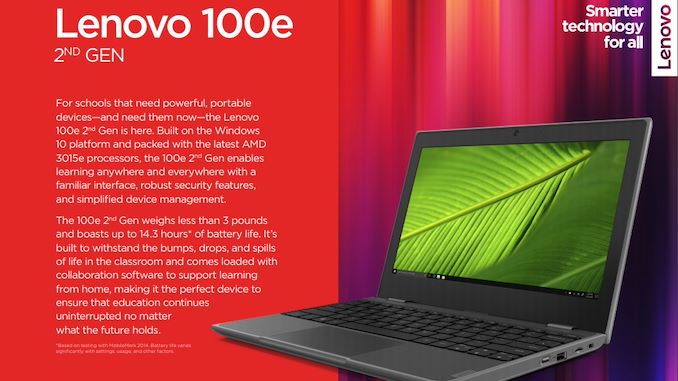AMD Zen now at 6W TDP: Dual Core for Education
by Dr. Ian Cutress on August 4, 2020 10:05 AM EST
At the low-end of AMD’s portfolio, the company uses Athlon Gold and Silver naming for parts that offer fewer cores and lower power consumption. These parts are still based on Zen or Zen+ microarchitecture, paired with a small amount of Vega graphics, indicating that this market is best served with something that is at a low-cost to manufacture but still of sufficient performance for the markets intended. Sitting below those Athlons, two new APUs have popped up in some new Lenovo education-focused designs today.
The two new processors dispense with the Athlon naming, as AMD gets right into it – the AMD 3015e and 3020e use the same lower case ‘e’ ending we last saw on a product line in 2011, indicating the super low power that these processors are rated for. These processors are given a TDP of 6W with two cores and Vega 3 graphics, traditionally what we see in low cost laptops but sufficient for education-style designs.
The silicon these new processors are based on, we believe, is AMD’s Dali silicon. It is the smallest of all AMD’s Zen APU silicon offerings, already in the market as AMD Athlon Mobile. These new parts come in below those specifications.
| AMD Dali-based Zen APUs | |||||||
| AnandTech | Cores Threads |
Base Freq |
Turbo Freq |
GPU | GPU Freq |
DDR4 | TDP |
| Athlon Gold 3150U | 2 / 4 | 2400 | 3300 | Vega 3 | 1000 | 2400 | 15 W |
| Athlon Silver 3050U | 2 / 2 | 2300 | 3200 | Vega 2 | 1100 | 2400 | 15 W |
| Athlon 300U | 2 / 4 | 2400 | 3300 | Vega 3 | 1000 | 2400 | 15 W |
| Athlon Silver 3050e | 2 / 4 | - | 2800 | Vega 3 | 1000 | 2400 | 6 W |
| AMD 3015e | 2 / 4 | 1200 | 2300 | Vega 3 | 600 | 1600 | 6 W |
| AMD 3020e | 2 / 2 | 1200 | 2600 | Vega 3 | 1000 | 2400 | 6 W |
If the set-up looks a bit odd, well, it is. The 3015e has simultaneous multi-threading but a much lower GPU frequency and DDR4 support compared to the 3020e. This might be the trade-off at the 6W power mode.
Lenovo is set to use the new AMD 3015e in two of its new education designs.
The Lenovo 100e 2nd Gen will use this new chip, Windows 10, Wi-Fi 6, 64 GB eMMC, 4 GB DDR4, an 11.6-inch 13x7 display (250 nits), but offer a hard wearing design suitable for bumps and scrapes as well as ~12 hours of battery life, with quick charging providing 80% power in an hour.
The Lenovo 300e 2nd Gen is a similar build but offers a 360-degree hinge, pen support, with an optional 128 GB SSD. Battery is 42 Wh, rated at ~12 hours.
The 100e will start at $219 and the 300e will start at $299, available from September. Both devices have a variety of student-focused software options focusing on teaching and security.











65 Comments
View All Comments
vithrell - Tuesday, August 4, 2020 - link
Standard mobile chips (15-45W) are one+ year behind desktop Ryzen CPUs and those "ultra mobile" ones are delayed even more. Until last September new Stoney Ridge based SKUs were premiering, only now they will move to Ryzen, probably they won't skip a generation and start with Zen1 arch.Luminar - Tuesday, August 4, 2020 - link
It's the other way around.Rudde - Tuesday, August 4, 2020 - link
The 'e' branded Stoney Ridge products were released in 2016 according to the wikipedia article.vithrell - Tuesday, August 4, 2020 - link
Oh yea, you are right, still not 2011.ceisserer - Tuesday, August 4, 2020 - link
What is the die size of Dali ... anyone?nandnandnand - Tuesday, August 4, 2020 - link
smol mm²Sahrin - Tuesday, August 4, 2020 - link
Given that Zen 2 has demonstrated the capability to run at 1W/core, I expect this part to hit 3-4W next year.AMD isn't getting nearly enough credit for using their process advantage to the fullest benefit in power consumption.
When Intel releases a product like this, the press furiously masturbates over how power efficient it is.
schujj07 - Tuesday, August 4, 2020 - link
Or keep the TDP the same and increase clock speed. Overall these low power Zen CPUs are in an interesting position. At these power & cost levels you will see CPUs from Intel based on Atom cores. A Zen core chip will have a much better user experience than an Atom powered device.Sahrin - Tuesday, August 4, 2020 - link
The 1W/Core figure is from 64-core Epyc reviews, which had all 64 cores running under 1W@3Ghz.On silicon, there isn't much room to go above that for clockspeed because of leakage current, etc and still stay below 1W. There's a reason that ARM chips only clock up to ~2.5Ghz. x86 CPU's tend to be tuned more towards clockspeed if only because in x86 applications you are much less concerned about thermals (even in an ultralight, your cooling situation is orders of magnitude better than in a phone).
serendip - Wednesday, August 5, 2020 - link
The nearest competitor is an old m3 or a Pentium Gold using Kaby Lake cores. These new chips have better turbo performance and much better GPUs.